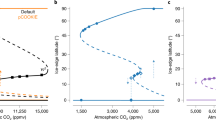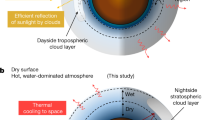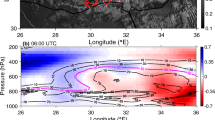Abstract
ACCORDING to the classical concept of general circulation of the Earth's atmosphere, two tropical Hadley cells give a large scale vertical upward motion on both sides of the equator. Contrary to this concept, there were some early observations, and many more satellite cloud observations in the past few years, which suggest subsidence somewhere very close to the equator. These observations are briefly summarized as follows. (a) Pilots crossing the equator during the Second World War frequently reported relative clearance of clouds over the equator compared with two regions of cloudiness on either side of it. On the basis of these reports, Fletcher1 attempted to build up a hypothesis of two equatorial indirect cells, one on each side of the equator, with a common limb of subsidence over the equator. Rossby2 attributed the well known semi-desert climate of Christmas Island in the Pacific at 2° N. to subsidence of this type. (b) Radiosonde ascents at Gan Island (00° 41′ S., 73° 09′ E.) and a few available upper air observations at mid-oceanic equatorial locations in the Indian Ocean during the International Indian Ocean Expedition of 1963–64 show characteristic dryness suggestive of subsidence3. (c) Recent daily satellite cloud photographs over the equatorial Indian Ocean regularly received here generally confirm the lack of much cloudiness in the mid-ocean. Sadler's monthly mean cloud data (personal communication) suggest that this clearance of the equator in mid-oceans is even more marked in the Atlantic and the Pacific than in the Indian Ocean. (d) The well known non-formation of tropical cyclone centres in a belt of 3°–4° latitude on either side of the equator appears to be connected with some persistent feature of subsidence in the region.
This is a preview of subscription content, access via your institution
Access options
Subscribe to this journal
Receive 51 print issues and online access
$199.00 per year
only $3.90 per issue
Buy this article
- Purchase on Springer Link
- Instant access to full article PDF
Prices may be subject to local taxes which are calculated during checkout
Similar content being viewed by others
References
Fletcher, R. D., J. Met., Amer. Met. Soc., 2, 167 (1945).
Rossby, C. G., in The Atmospheres of the Earth and Planets (edit. by Kuiper, G. P.), 16 (1949).
Asnani, G. C., and Pisharoty, P. R., Proc. Intern. Indian Ocean Exped. Symp., Bombay (in the press).
Author information
Authors and Affiliations
Rights and permissions
About this article
Cite this article
ASNANI, G. Subsidence near the Equator. Nature 214, 73–74 (1967). https://doi.org/10.1038/214073a0
Received:
Revised:
Issue Date:
DOI: https://doi.org/10.1038/214073a0
This article is cited by
-
Five-day oscillation in East African low-level jet
Nature (1978)
-
Mechanisms effecting the state, evolution and transition of the planetary scale monsoon
Pure and Applied Geophysics PAGEOPH (1977)
Comments
By submitting a comment you agree to abide by our Terms and Community Guidelines. If you find something abusive or that does not comply with our terms or guidelines please flag it as inappropriate.



